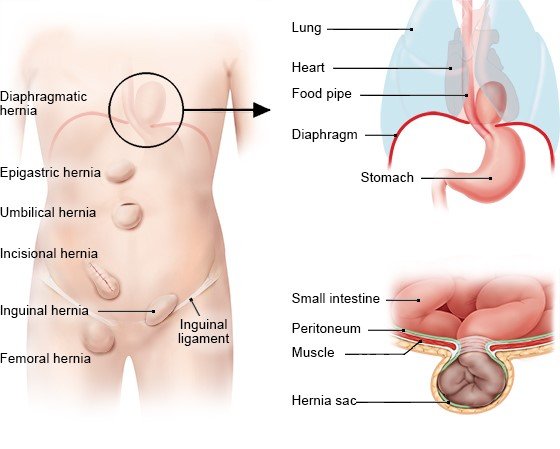Hernia
Hernias mostly happen when part of your intestine or the lining of your belly pushes through a weak spot in your belly muscles. This creates a bulge, sometimes called a hernia sac, which you can usually see or feel. Other organs like your stomach can also get pushed into this bulge. Whether it causes trouble or not depends on how big it is and where it is in your body.
Symptoms
Hernias usually can be feet or seen as bulges. Sometimes they don't hurt, but they can cause pain, burning, or a pulling feeling, especially when you're using your muscles. Big hernias can be uncomfortable and upsetting. If a hernia pinches part of your intestine, you might have tummy troubles. In men, a hernia can even make the scrotum swell up. Sudden pain or pain with nausea or vomiting can be a sign of a dangerous blockage. Hernias inside your body are different and can cause heartburn, trouble swallowing, or difficulty breathing. These can be treated with medicine or surgery.
Causes and Risk factors
Hernias are more likely to happen if you have weak muscles in your belly or weak tissues holding things together. This weakness can be something you're born with, something that happens as you get older, or caused by illness or surgery. Being very overweight can increase pressure in your belly, but this only affects certain types of hernias, not all of them. Other things that put pressure on your belly, like tumors or fluid buildup, can also increase the risk. Pregnant women are more likely to get hernias, too. Smoking and illnesses like diabetes make it harder for wounds to heal, which makes some hernias more likely after surgery. If you already have a hernia, lifting heavy things, coughing, and straining can make it bigger.
Repeated strains on the abdominal and groin areas may cause a hernia. Such strains may come by:
Physical exercise
Straining during bowel movements
Pregnancy
Chronic coughing or sneezing
Constipation
These are the most common types of hernias:
Inguinal hernia: An inguinal hernia occurs when fatty tissue or part of the intestine protrudes through the abdominal wall or into the inguinal canal in the groin. This is the most common type of hernia that occurs more frequently in men than in women.
Femoral hernia: Femoral hernias develop when the intestine protrudes through the canal carrying the femoral artery and vein into the upper thigh. Because of the wider bone structure, femoral hernias tend to mainly affect older women.
Umbilical hernia: Umbilical hernias occur when fatty tissue or a part of the intestine pushes through the abdominal wall near the navel. This umbilical hernia is most common in newborns and pregnant women.
Hiatal hernia: Hiatal hernia happens when the upper part of the stomach bulges through an opening in the diaphragm. The diagram is the muscle that separates the chest from the abdomen that helps you breathe.
Incisional hernia: Incisional hernia or ventral hernias occurs when the tissue protrudes through the abdominal scar from previous abdominal surgery. However, incisional hernias do not go away on their own and require surgical treatment.
Epigastric hernia: An epigastric hernia is a type of hernia that develops in the epigastric region of the abdominal wall (above the belly button and just below the sternum).
Spigelian hernia: This hernia occurs when intestine protrudes through the abdomen at the side of the abdominal muscle, below the navel.
Diaphragmatic Hernia: A diaphragmatic hernia that occurs due to a birth defect, in which there is an abnormal opening in the diaphragm.
Treatments
If the hernia is growing larger or causing pain then the hernia surgery is recommended to fix your painful hernias. The hernia surgeon repairs the hernia by sewing the hole in the abdominal wall closed during the surgery.
Although surgical options of hernias depend on the location and type of hernia, there are two main types of hernia surgery.
Open surgery: Most of the hernias in the abdominal wall are fixed under general anesthesia through cuts or large incisions. The surgeon gently pushes the hernia back into place, tie it off or remove it. Then the surgeon will close the weak area of the muscle where the hernia is pushed through with stitches.
Laparoscopic surgery: Laparoscopic hernia surgery is similar to other laparoscopic procedures. The surgeon uses a tiny camera and miniaturized surgical equipment to repair the hernia through small incisions in the lower abdomen. Laparoscopic repair of a hernia is less likely to cause infections. Also, we must follow appropriate precautions after hernia surgery.
Hernias don’t always have to be operated on. If they aren’t causing any problems and the risk of complications is low, surgery isn’t needed. This is also true in people who are very old, weak or seriously ill and have a hernia that doesn’t pose an acute risk. People who have an inguinal hernia, on the other hand, are usually advised to have surgery.
It’s important to recognise the early symptoms of a hernia because untreated hernias will not heal on their own. However, with early medical care, you can minimise the effects of hernia and avoid life-threatening complications. Our hernia surgery experts are capable of treating all types of hernias in a pain-free and patient-friendly manner.


Bright Kidney Care Hospital
Copyright © 2024. All Rights Reserved.
